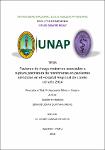| dc.description.abstract | La ruptura prematura de membranas (RPM) es una de los problemas obstétricos más comunes en el que se presenta solución de continuidad de las membranas corioamnióticas con pérdida de líquido amniótico antes del inicio del trabajo de parto. Se presenta con una frecuencia del 10% de todos los embarazos y ocupa el quinto lugar entre las condiciones maternas primarias causales de muerte fetal y el primero para la mortalidad neonatal. Existen una serie de factores de riesgo frecuentes descritas en la literatura lo que trae consigo que el parto se produzca antes del término de la gestación. Objetivo: Determinar los factores de riesgo asociados a ruptura prematura de membranas en pacientes atendidas en el Hospital Regional de Loreto durante enero a diciembre del año 2014.El tipo de estudio fue el tipo cuantitativo, observacional, retrospectivo, y correlacional, de diseño caso – control; la investigación se llevó a cabo utilizando datos de sistemas de registro y/o historias clínicas que permiten identificar fácilmente a los sujetos que desarrollaron el evento en estudio (casos) y los que no desarrollaron el evento (controles), se aplicó una ficha de recolección de datos que se confecciono para el presente estudio. El grupo control fue 2 veces la cantidad del grupo de casos, pareadas en algunas características con los casos, como parto realizado el mismo día (sea minutos u horas antes o después del caso), similar grupo etáreo (±1-2 años de diferencia) y similar edad gestacional (±1- 2 semanas). La población de estudio estuvo constituida por todas las pacientes gestantes que fueron atendidas y hospitalizadas en el Servicio de Gineco-obstetricia del Hospital Regional de Loreto durante el año 2014. Para determinar el nivel de riesgo de morbilidad de una determinada variable para desarrollar RPM, se ha calculado el Odds Ratio (OR), asimismo se realizó un análisis multivariado, a través del modelo de regresión logística múltiple para detectar y controlar las posibles variables confusoras.Las variables encontradas en el modelo bivariado como factores de riesgo a RPM fueron: procedencia rural (OR: 1,752; IC95%: 1,003 - 3,059), primigesta (OR:2,42; IC95%:1,720 - 3,404), nuliparidad (OR: 2,453; IC95%: 1,748 - 3,442), sin periodo intergenésico (OR:1,960; IC95%:1,387 - 2,768), historia de un aborto (OR: 1,599; IC95%:1,038 - 2,465), infección urinaria (OR:2,641; IC95%: 1,868 - 3,734), infección vaginal (OR: 3,283; IC95%: 1,061 - 10,155), tener menos de 6 controles prenatales (OR: 2,677; IC95%:1,912 - 3,748). El modelo multivariado indica que la ITU (OR ajustado: 2,03; IC95%:1,394 - 2,956), tener menos de 6 controles prenatales (OR ajustado: 2,31; IC95%:1,614 3,308) y la anemia gestacional (OR ajustado: 1,69; IC95%: 1,181 - 2,426) son factores de riesgo significativo sin intervención de variables confusoras. Presentar infección urinaria durante la gestación o tener menos de 6 controles prenatales, eleva a más del doble la probabilidad de RPM en gestantes atendidas en el Hospital Regional de Loreto el año 2014, mientras que presentar anemia durante el embarazo lo hace en 1,6 veces, de manera significativa, estimación ajustada por otras variables de confusión. | es_PE |
| dc.description.abstract | Premature rupture of membranes (PROM) is one of the most common obstetric problems in which continuity solution chorioamniotic membranes occurs with loss of amniotic fluid before the onset of labor. It comes with a frequency of 10% of all pregnancies and is ranked fifth among the primary causes of maternal conditions stillbirth and the first for neonatal mortality. There are a number of common risk factors described in the literature which brings the birth occurs before the end of gestation.
Objective: To determine the risk factors associated with premature rupture of membranes in patients treated at the Regional Hospital of Loreto during January to December 2014. The type of quantitative study was observational, retrospective, and correlational, case design - Control; research was conducted using data from registration systems and / or medical records that allow you to easily identify subjects who developed the event under study (cases) and those who did not develop the event (controls), a record collection was applied data was compiled for this study. The control group was 2 times the amount of the case group, paired in some characteristics with cases such as childbirth done the same day (either minutes or hours before or after the event), similar age group (± 1-2 years apart ) and a similar gestational age (± 1- 2 weeks). The study population consisted of all pregnant patients who were treated and hospitalized in the Department of Gynecology and Obstetrics of the Regional Hospital of Loreto in 2014. To determine the level of risk of morbidity of a given variable to develop RPM, is he has calculated the odds ratio (OR), also a multivariate analysis was performed through model multiple logistic regression to detect and control possible confounding variables.The variables found in the bivariate model as RPM risk factors were: rural origin (OR: 1.752; 95% CI: 1.003 to 3.059), first pregnancy (OR: 2.42; 95% CI: 1.720 to 3.404), Nulliparity ( OR: 2.453; 95% CI: 1.748 to 3.442), without intergenesic period (OR: 1.960; 95% CI: 1.387 to 2.768), history of abortion (OR: 1.599; 95% CI: 1.038 to 2.465), urinary tract infection (OR: 2,641; 95% CI: 1.868 to 3.734), vaginal infection (OR: 3.283; 95% CI: 1.061 to 10.155), less than 6 prenatal controls (OR: 2.677; 95% CI: 1.912 to 3.748). The multivariate model indicates that the ITU (adjusted OR: 2.03; 95% CI: 1.394 to 2.956), less than 6 prenatal visits (adjusted OR: 2.31; 95% CI: 1.614 to 3.308) and gestational anemia (OR adjusted: 1.69; 95% CI: 1.181 to 2.426) are significant risk factors without the intervention of confounding variables.Present urinary tract infection during gestation or less than 6 prenatal visits, rises to more than double the likelihood of RPM in pregnant women treated at the Regional Hospital of Loreto 2014, while presenting anemia during pregnancy does 1, 6 times, significantly adjusted estimate for other confounding variables. | es_PE |


